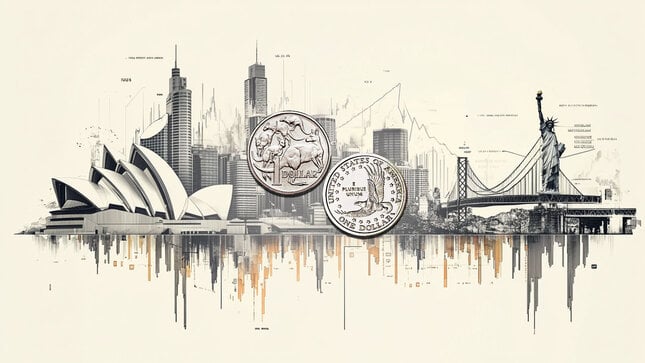- AUD/USD rebounds to around 0.6010 in Tuesday’s Asian session.
- Investors raise their bets the Fed will cut interest rates aggressively as Trump's tariffs raise US recession fears.
- The RBA is anticipated to cut interest rates at their next meeting.
The AUD/USD pair recovers some lost ground to near 0.6015 during the early Asian session on Tuesday. The US Dollar (USD) edges higher against the Aussie amid concerns over a recession in the United States following US President Donald Trump's sweeping tariffs on trading partners.
Analysts believe that the uncertainties surrounding the new Trump tariff policy will likely increase inflation and make a US recession more likely. Traders are stepping up bets the US Federal Reserve (Fed) will cut interest rates aggressively this year. According to the CME FedWatch tool, the markets have priced in a nearly 65% chance of a Fed cut in May, and futures now point to about 100 basis points (bps) worth of rate reductions by December.
On the Aussie front, the rising speculation that the Reserve Bank of Australia (RBA) could deliver faster and deeper rate cuts than previously expected could undermine the Australian Dollar (AUD) in the near term. The RBA will meet in May, and a 25 bps rate cut is likely, with a jumbo 50 bps reduction a slight possibility.
Meanwhile, China announced last Friday that it will impose 34% counter-tariffs on the US, taking effect Thursday, as part of a retaliatory reaction to Trump's tariffs. The escalating trade war between the two largest economies in the world would damage the Australian economy and weigh on the AUD, as China is its biggest trading partner.
China announced last Friday that it will impose a 34% tax on all US imports, taking effect Thursday, as part of a retaliatory reaction to Trump's tariffs. This marks Beijing's toughest retaliation to the American leader's trade war. The concerns over trade tensions between the world's two biggest economies exert some selling pressure on the China proxy, as China is a major trading partner to Australia.
Australian Dollar FAQs
One of the most significant factors for the Australian Dollar (AUD) is the level of interest rates set by the Reserve Bank of Australia (RBA). Because Australia is a resource-rich country another key driver is the price of its biggest export, Iron Ore. The health of the Chinese economy, its largest trading partner, is a factor, as well as inflation in Australia, its growth rate and Trade Balance. Market sentiment – whether investors are taking on more risky assets (risk-on) or seeking safe-havens (risk-off) – is also a factor, with risk-on positive for AUD.
The Reserve Bank of Australia (RBA) influences the Australian Dollar (AUD) by setting the level of interest rates that Australian banks can lend to each other. This influences the level of interest rates in the economy as a whole. The main goal of the RBA is to maintain a stable inflation rate of 2-3% by adjusting interest rates up or down. Relatively high interest rates compared to other major central banks support the AUD, and the opposite for relatively low. The RBA can also use quantitative easing and tightening to influence credit conditions, with the former AUD-negative and the latter AUD-positive.
China is Australia’s largest trading partner so the health of the Chinese economy is a major influence on the value of the Australian Dollar (AUD). When the Chinese economy is doing well it purchases more raw materials, goods and services from Australia, lifting demand for the AUD, and pushing up its value. The opposite is the case when the Chinese economy is not growing as fast as expected. Positive or negative surprises in Chinese growth data, therefore, often have a direct impact on the Australian Dollar and its pairs.
Iron Ore is Australia’s largest export, accounting for $118 billion a year according to data from 2021, with China as its primary destination. The price of Iron Ore, therefore, can be a driver of the Australian Dollar. Generally, if the price of Iron Ore rises, AUD also goes up, as aggregate demand for the currency increases. The opposite is the case if the price of Iron Ore falls. Higher Iron Ore prices also tend to result in a greater likelihood of a positive Trade Balance for Australia, which is also positive of the AUD.
The Trade Balance, which is the difference between what a country earns from its exports versus what it pays for its imports, is another factor that can influence the value of the Australian Dollar. If Australia produces highly sought after exports, then its currency will gain in value purely from the surplus demand created from foreign buyers seeking to purchase its exports versus what it spends to purchase imports. Therefore, a positive net Trade Balance strengthens the AUD, with the opposite effect if the Trade Balance is negative.
BRANDED CONTENT
Finding the right broker for your trading strategy is essential, especially when specific features make all the difference. Explore our selection of top brokers, each offering unique advantages to match your needs.
Information on these pages contains forward-looking statements that involve risks and uncertainties. Markets and instruments profiled on this page are for informational purposes only and should not in any way come across as a recommendation to buy or sell in these assets. You should do your own thorough research before making any investment decisions. FXStreet does not in any way guarantee that this information is free from mistakes, errors, or material misstatements. It also does not guarantee that this information is of a timely nature. Investing in Open Markets involves a great deal of risk, including the loss of all or a portion of your investment, as well as emotional distress. All risks, losses and costs associated with investing, including total loss of principal, are your responsibility. The views and opinions expressed in this article are those of the authors and do not necessarily reflect the official policy or position of FXStreet nor its advertisers. The author will not be held responsible for information that is found at the end of links posted on this page.
If not otherwise explicitly mentioned in the body of the article, at the time of writing, the author has no position in any stock mentioned in this article and no business relationship with any company mentioned. The author has not received compensation for writing this article, other than from FXStreet.
FXStreet and the author do not provide personalized recommendations. The author makes no representations as to the accuracy, completeness, or suitability of this information. FXStreet and the author will not be liable for any errors, omissions or any losses, injuries or damages arising from this information and its display or use. Errors and omissions excepted.
The author and FXStreet are not registered investment advisors and nothing in this article is intended to be investment advice.
Recommended content
Editors’ Picks

AUD/USD holds steady above 0.6400 amid mixed cues
AUD/USD consolidates above the 0.6400 mark during the Asian session on Tuesday. Concerns about the rapidly escalating US-China trade war act as a headwind for the Aussie. The US Dollar languishes near a multi-year low amid the uncertainty over Trump's trade policies and the weakening confidence in the US economy.

USD/JPY recovers slightly from multi-month low; upside seems limited
USD/JPY ticks higher during the Asian session on Tuesday and recovers a part of the previous day's downfall to a fresh seven-month low, though any meaningful upside seems elusive. Trade war concerns, global recession fears, hopes for a US-Japan trade deal, and the divergent BoJ-Fed expectations should continue to underpin the JPY.

Gold price hits fresh record high amid the global rush to safety
Gold price touched a fresh all-time peak, around the $3,444-3,445 area during the Asian session on Tuesday amid worries that an all-out trade war could trigger a global recession. Doubt over Fed independence, which led to the overnight USD slump to a three-year low, and heightened Russia-Ukraine tensions act as a tailwind for the XAU/USD.

ARK Invest integrates Canada's 3iQ Solana Staking ETF into its crypto funds
Asset manager ARK Invest announced on Monday that it added exposure for Solana staking to its ARK Next Generation Internet exchange-traded fund and ARK Fintech Innovation ETF through an investment in Canada's 3iQ Solana Staking ETF.

Five fundamentals for the week: Traders confront the trade war, important surveys, key Fed speech Premium
Will the US strike a trade deal with Japan? That would be positive progress. However, recent developments are not that positive, and there's only one certainty: headlines will dominate markets. Fresh US economic data is also of interest.

The Best brokers to trade EUR/USD
SPONSORED Discover the top brokers for trading EUR/USD in 2025. Our list features brokers with competitive spreads, fast execution, and powerful platforms. Whether you're a beginner or an expert, find the right partner to navigate the dynamic Forex market.



